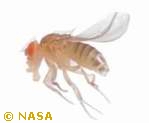Sunday, October 01, 2006
A Fly's-Eye View of Evolution (Drosophila melanogaster)
Howard Hughes Medical Institute (HHMI) researchers have found that mutations in a single structural protein can determine whether an insect develops the highly organized, light-harvesting eye that flies have, or the optically simpler compound eye of a beetle or bee.
In their experiments, the scientists showed that flies without this structural protein develop a more primitive eye. This outcome was reversed in the laboratory when researchers supplied the missing protein to a more primitive eye system, inducing it to "evolve" into the more advanced eye.
Working with the fruit-fly Drosophila melanogaster, the researchers explored the formation of transparent rod-like structures in the compound eye called rhabdomeres. Rhabdomeres feed light to the bundles of photoreceptors that comprise each of the 800 unit eyes in the fly's compound eyes. Rhabdomeres are fused into a single light-gathering structure in the more primitive "closed rhabdom" compound eyes of beetles, bees, and some mosquitoes. Flies, on the other hand, have evolved a more advanced "open rhabdom" structure. In the more sophisticated eyes of flies, the rhabdomeres are separated, and as a result, fly eyes have significantly better angular resolution, and can detect smaller moving objects. [Evolution, Science]
Continued at "A Fly's-Eye View of Evolution"
-------
Based on the journal Nature paper "Transforming the architecture of compound eyes" (Abstract: here or here)
Also see "Hard-wiring The Fruit Fly's Visual System (Current Biology)"
Technorati: howard, hughes, medical, institute, insect, eye, flies, organized, light, optically, simpler, beetle, bee, experiments, structural, protein, develop, primitive, laboratory, system, evolve, advanced, fruit-fly, drosophila, melanogaster, formation, transparent, rod, photoreceptors, mosquitoes, angular, resolution, evolution, science, research, hhmi
Add to: CiteUlike | Connotea | Del.icio.us | Digg | Furl | Newsvine | Reddit | Yahoo
